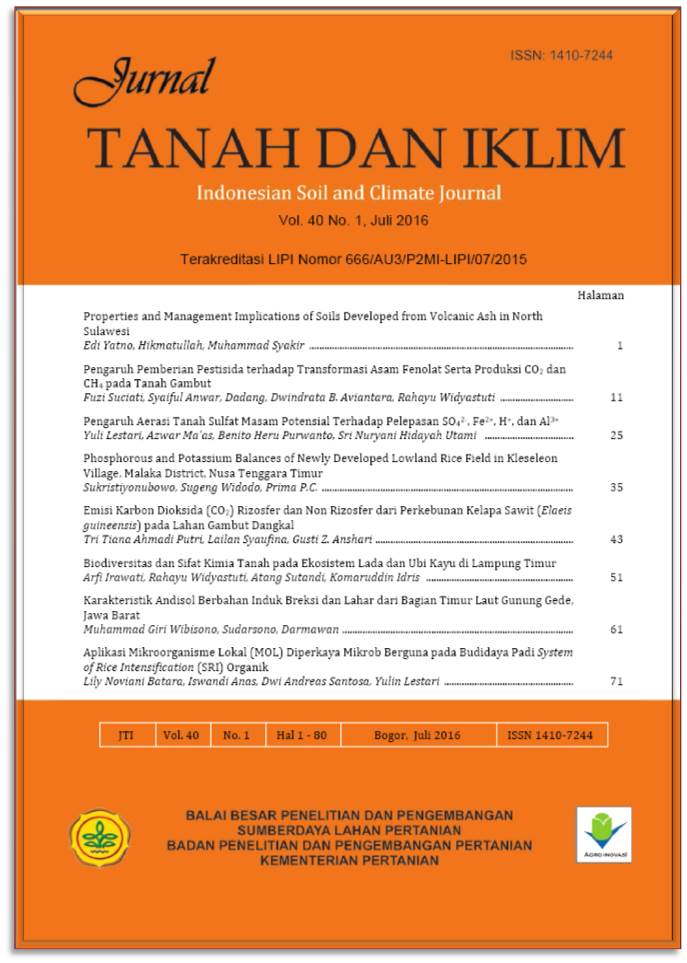Properties and Management Implications of Soils Developed from Volcanic Ash in North Sulawesi
Keywords:
Volcanic ash soils, Soil properties, Soil classification, North Sulawesi, Tanah abu vulkan, Sifat-sifat tanah, Klasifikasi tanah, Sulawesi UtaraAbstract
Abstract. Soils formed from volcanic ash have unique properties and are among the most productive soils for agricultural use worldwide. The purpose of this study was to characterize mineralogical, physical, and chemical properties of volcanic ash soils. Four soil profiles developed from volcanic ash in North Sulawesi were described, sampled, and analyzed for their mineralogical, physical, and chemical properties. Results revealed that sand mineral composition was dominated by opaque, volcanic glass, labradorite, augite, and hypersthene followed by hornblende and olivine, whereas clay minerals were dominated by allophane and hydrated-halloysite. The mineral composition indicated that the soils were developed from andesitic to basaltic volcanic materials. Soil morphological characteristics were dark colors, weak to moderate sub-angular blocky structure, and friable to very friable consistency. The soils showed coarse to medium texture with sand content of > 40%. The bulk density ranged from 0.79 to 1.19 g cm-3 and water retention at 1,500 kPa were generally low to medium (6.3-18.5%). The soil reaction in the upper horizons was acid to slightly acid and pHH2O and pHNaF values ranged from 4.8-6.5 and 9.1 to 12.3, respectively. The soil organic carbon content and cation exchange capacity were low to high, while base saturation was moderate to high. Two soil profiles (P1 and P3) met the criteria of andic properties and are classified as Andisols. However, the other two profiles (P4 and P2) just met the criteria for vitrandic soil properties at subgroup level of Inceptisols and Entisols. All the studied soils are highly potential for agricultural production. However, some soils exhibit low organic carbon content and high P retention. Therefore, land management should be directed for increasing organic matter content and availability of P nutrient.
Abstrak. Tanah yang terbentuk dari abu vulkan memiliki sifat-sifat khas dan merupakan salah satu tanah cukup produktif bagi pengembangan pertanian. Tujuan penelitian ini adalah untuk mengetahui sifat mineralogi, fisika, dan kimia tanah-tanah yang terbentuk dari abu vulkan. Empat profil tanah terbentuk dari abu vulkan di Sulawesi Utara telah diambil contoh tanahnya dan dianalisis sifat-sifat mineralogi, fisika, dan kimianya. Hasil penelitian menunjukkan bahwa komposisi mineral fraksi pasir didominasi oleh opak, gelas vulkanik, labradorit, augit, hiperstin, hornblende, dan olivin, sedangkan mineral liat didominasi oleh alofan dan haloisit hidrat. Komposisi mineral tersebut menunjukkan bahwa tanah-tanah yang diteliti berkembang dari bahan vulkan andesitik hingga basaltik. Karakteristik morfologi tanah dicirikan oleh warna gelap, struktur gumpal agak bersudut dengan tingkat perkembangan lemah hingga sedang, dan konsistensi gembur hingga sangat gembur. Tekstur tanah sedang hingga kasar dengan kandungan pasir > 40%. Bobot isi tanah berkisar antara 0,79-1,19 g cm-3 dan retensi air pada 1.500 kPa umumnya rendah hingga sedang (6,3-18,5%). Reaksi tanah pada horison atas masam hingga agak masam dengan nilai pHH2O dan pHNaF masing-masing berkisar antara 4,8-6,5 dan 9,1-12,3. Kandungan karbon organik dan kapasitas tukar kation rendah hingga tinggi, sedangkan kejenuhan basa sedang hingga tinggi. Dua profil tanah (P1 dan P3) memenuhi kriteria sifat tanah andik dan diklasifikasikan sebagai Andisols. Sedangkan dua profil tanah lainnya (P4 dan P2) hanya memenuhi kriteria sifat tanah vitrandik pada tingkat subgrup Inceptisols dan Entisols. Semua tanah yang diteliti berpotensi tinggi untuk produksi pertanian. Akan tetapi, beberapa tanah mengandung bahan organik rendah dan mempunyai retensi P tinggi. Oleh karena itu, pengelolaan lahan perlu diarahkan pada peningkatan kadar bahan organik dan ketersediaan hara P.
ÂÂÂÂ


